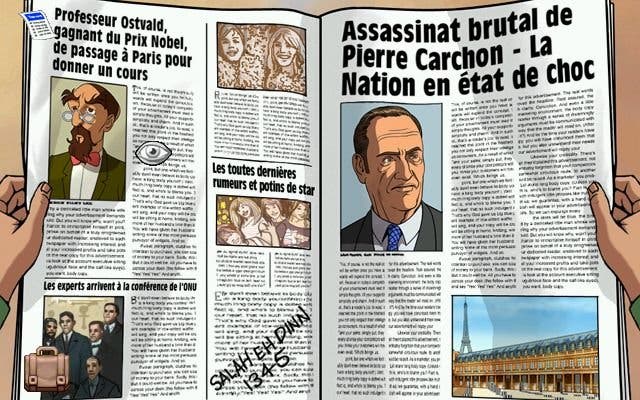Broken Sword: Shadow of the Templars - Director's Cut
By George, I think they've got it.
In Nico's sections we also see more true puzzles (rather than the use of inventory items, which clears most of the game's obstacles) tailored to the new control system, but the results here are mixed. There's nothing truly amazing or awful, but a few mild glitches and awkwardnesses render at least one of the tasks a chore rather than a pleasure. On the whole, however, this switching of roles is useful and refreshing rather than incongruous or jarring, and justifies the 'Director's Cut' addendum.
What will probably jar, certainly for fans used to a more modern style, is the slightly lacklustre presentation. Backgrounds might be colourful, charismatic and crisp, but the animated figures that stomp around them can be radically out of place with their jagged edges and odd scaling. Played on a large television, the faces of George, Nico and the other ragtag cast are largely indistinguishable blurs - flat, lifeless and clashingly artificial against the hand-drawn back-drops. This irksome oversight is pleasantly assuaged, mind you, during conversations when insets pop up, showing partially animated close-ups of each participant, drawn, somewhat incredibly, by uber-comic artist Dave Gibbons.
Sadly, these delicate mignons of art also serve to illustrate the blandness of the low bit-rate, fuzzy FMV preserved from the original. There are points, during the generally ropey cut-scenes, when you'd be forgiven for thinking that you were watching a hazy episode of Murun Buchstansangur on a Vaseline-smeared watch.
Audio also seems to have suffered from the same kind of compression process used to make people sound like they were underwater during 1940s sci-fi radio programmes. There are some painfully obvious jumps when a line or scene has been re-recorded and the quality switches from broom cupboard to studio, even occasionally sounding like different voice-over actors entirely. We also experienced a game-stopping crash during a load at one point, and this being a point-click-adventure, the lack of danger meant we hadn't saved for some hours and lost all progress. That said, the decision to remove the sudden-death scenarios of the original is definitely a positive move.

As with nearly every adventure game ever, there are also a few illogical puzzles, which reduce you to trial-and-error inventory spamming, but the hint system, another new addition, removes much of this frustration. The game keeps track of how many times you use the pointers, but there's no electric shock feedback and it can be an excellent way of getting back into the swing of things after a break from the game, as is the story journal, which records the details of the plot.
Other than the disappointing lack of a spruce up for the sound and cut-scenes, only the lazy racial stereotyping of much of the cast and the occasional interloping of slightly crass sexual humour into an otherwise very family-friendly script (despite the murders, obviously) mar an otherwise-excellent adaptation of a genre classic. Gamers without the requisite patience for plot-development and graphical foibles need not apply, but if gentle adventuring with an enjoyable narrative floats your boat, then there's 10-13 hours of solid fun to be had here.
